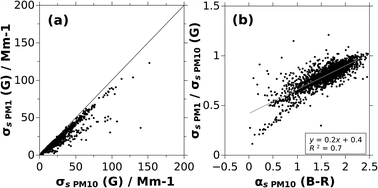Comparison between the optical properties of aerosols in the fine and coarse fractions over Valladolid, Spain
Abstract
Continuous measurements of the optical properties of aerosol particles have been made at Valladolid, Spain, covering the period from June 2011 to July 2012. The measurements were made at two size cuts: sub-10 μm and sub-1 μm (PM10 and PM1). The data measured were the scattering and backscattering coefficients, σs and σbs, obtained from an integrating nephelometer, and the absorption coefficient, σa, obtained from a particle soot absorption photometer. Spectrally resolved data were obtained from both instruments at 3 wavelengths (blue/green/red) at low relative humidity (RH < 40%). The statistical data for the instruments were calculated based on the hourly averages. For the PM10 fraction, the hourly mean values of σs and σa at 550 nm were 33 Mm−1 (StD = 30 Mm−1) and 4 Mm−1 (StD = 3 Mm−1), respectively. For the PM1 fraction, σs and σa mean values were 16 Mm−1 (StD = 14 Mm−1) and 4 Mm−1 (StD = 3 Mm−1), also at 550 nm. The derived parameters analyzed were the single scattering albedo, ω0, the backscatter fraction, σbs/σs, and the Ångström exponents of scattering, absorption and single scattering albedo, αs, αa and αω0. The contribution of the PM10 and the PM1 fractions for all these parameters plays a central role throughout the paper, allowing an improved classification of aerosol types. Our data are dominated by elemental carbon (EC) and elemental carbon/organic carbon mixed (EC/OC). For the PM10 data, dust dominated aerosol is also observed. Although we found that fine particles contribute more than coarse particles for decreasing the ω0 values, results suggest that it is also necessary to quantify the effect of coarse particles. Fine particles were found to produce ω0 spectra that decrease with the wavelength, αω0 > 0, while PM10 fractions were found to produce spectra that can decrease or increase with the wavelength, 0 < αω0 < 0. Both daily cycle and monthly variations are analyzed and related to local features as well as the transport of particles from elsewhere. A diurnal pattern characteristic of urban areas is observed, but it is less evident on weekends. The main long range transport influences are Atlantic advection, anthropogenic events from Central Europe and dust events.



 Please wait while we load your content...
Please wait while we load your content...